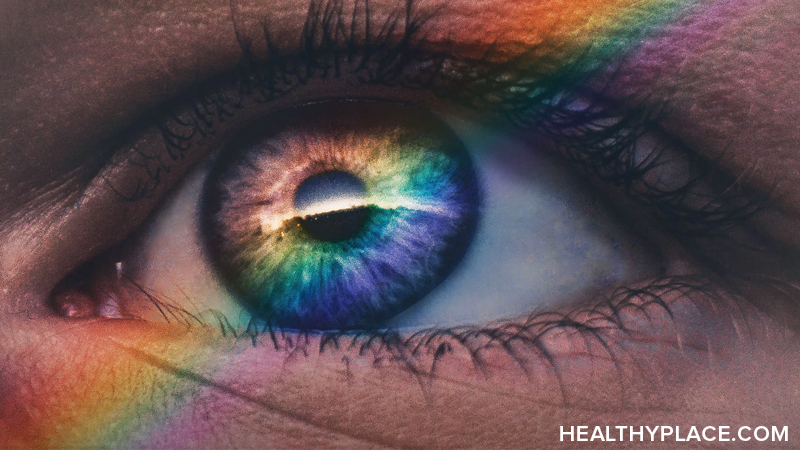Being Transgender and Having Bipolar Disorder

I live as a transgender person, and I also have bipolar disorder. While being transgender is not a mental illness, these two things still have a lot in common. Over the years, I've reflected on what these two things share. Today, I'll discuss the commonalities between them and what it feels like to live both as a transgender person and as a person with bipolar disorder.
Definitions About Being Transgender and Having Bipolar Disorder
It might be helpful to start by defining what both of these terms mean and to clarify the differences. In short, being transgender (trans) means not identifying with the gender one was assigned at birth. For example, I was assigned female at birth and now identify as either male or non-binary. (I am also gender fluid, so my gender shifts over time and isn't constant.)
In contrast, bipolar disorder is a type of mood disorder. In the HealthyPlace guide about bipolar disorder (which, by the way, is a fabulous resource if you're looking to learn more about bipolar disorder), bipolar disorder is defined as:
"an 'affective' or 'mood' disorder that primarily affects your mood (although there are other effects as well) and it is usually diagnoses and treated by a psychiatrist."
While a therapist or a psychiatrist can help to diagnose gender dysphoria, this isn't the same thing as being transgender. Most people who realize they are transgender figure this out on their own in the coming out process, and it does not require a medical professional to diagnose unless you're looking to pursue medical transition and need your insurance to cover services (you can learn more on medical transitions in my video below).
Statistics Being Transgender and Having Bipolar Disorder
Now, let's look at some statistics about how common both of these things are. It is estimated that 1.6 million Americans (approximately 0.5 percent) are transgender or non-binary, although it is estimated that these numbers are not entirely accurate, and actual numbers are much higher.1 It is estimated that approximately 5.7 million Americans live with bipolar disorder (about 2.6 percent of the population).2
In both the case of being transgender and having bipolar disorder, actual numbers may be higher, as stigma and underreporting may influence these statistics.
3 Commonalities Between Being Transgender and Having Bipolar Disorder
In the video below, I share three things in common between being transgender and having bipolar disorder.
Most interestingly, research suggests there may be a connection between being transgender and having bipolar disorder. While research on the connection between bipolar disorder and being transgender is somewhat scarce, a study conducted in 2019 found that transgender patients had a statistically significant increase in the prevalence of all psychiatric disorders, including bipolar disorder. In this study, the lifetime prevalence of bipolar disorder was found to be 11 percent, compared with the study listed above, which cited 2.6 percent of the general population as having bipolar disorder.3
As to why this may be the case, it seems additional research is needed on the topic. All I can say is that, in my life, I have met a lot of transgender folks who also have bipolar disorder, and I hope that one day someone will help answer the question "why." (Interestingly, research has also been conducted to suggest a connection between neurodivergence and being transgender, but more on that in a future post.4)
Sources
- Allen, J. (2022, June 10). New study estimates 1.6 million in U.S. identify as transgender. Reuters. https://www.reuters.com/world/us/new-study-estimates-16-million-us-identify-transgender-2022-06-10/
-
Bipolar Disorder Statistics - Depression and Bipolar Support Alliance. (2019, July 12). Depression and Bipolar Support Alliance. https://www.dbsalliance.org/education/bipolar-disorder/bipolar-disorder-statistics/
-
Wanta, J. W., Niforatos, J. D., Durbak, E., Viguera, A. C., & Altinay, M. (2019). Mental health diagnoses among transgender patients in the clinical setting: an All-Payer Electronic Health Record study. Transgender Health, 4(1), 313–315. https://doi.org/10.1089/trgh.2019.0029
-
Dattaro, L. (2022, August 16). Largest study to date confirms overlap between autism and gender diversity. Spectrum | Autism Research News. https://www.spectrumnews.org/news/largest-study-to-date-confirms-overlap-between-autism-and-gender-diversity/
APA Reference
Lyons, D.
(2023, September 27). Being Transgender and Having Bipolar Disorder, HealthyPlace. Retrieved
on 2025, December 20 from https://www.healthyplace.com/blogs/thelifelgbt/2023/9/being-transgender-and-having-bipolar-disorder
